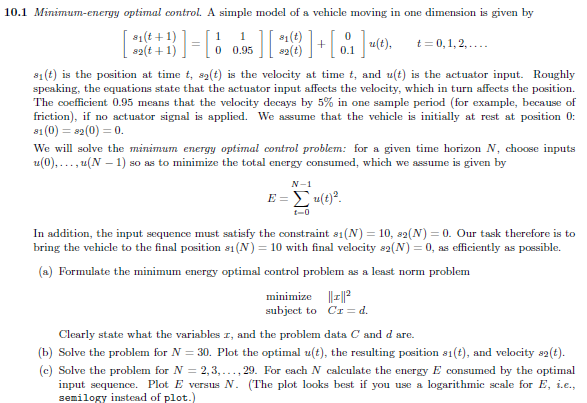
10.1 Minimum-energy optimal control. A simple model of a vehicle moving in one dimension is given by 31(t+1) 1 81(0) 32(t+1) t = 0,1,2,... 31(t) is the position at time t, sh(t) is the velocity at time t, and u(t) is the actuator input. Roughly speaking, the equations state that the actuator input affects the velocity, which in turn affects the position. The coefficient 0.95 means that the velocity decays by 5% in one sample period (for example, because of friction), if no actuator signal is applied. We assume that the vehicle is initially at rest at position 0: 81(0) = 82(0) = 0. We will solve the minimum energy optimal control problem for a given time horizon N, choose inputs 2(0),..., (N-1) so as to minimize the total energy consumed, which we assume is given by N-1 = u(t)2. In addition, the input sequence must satisfy the constraint 31(N) = 10, 32(N) = 0. Our task therefore is to bring the vehicle to the final position 81(N) = 10 with final velocity 32(N) = 0, as efficiently as possible. (a) Formulate the minimum energy optimal control problem as a least norm problem minimize ||- || subject to Cr=d. Clearly state what the variables I, and the problem data C and d are. (b) Solve the problem for N = 30. Plot the optimal u(t), the resulting position 31(t), and velocity 32(t). (c) Solve the problem for N = 2,3,..., 29. For each N calculate the energy E consumed by the optimal input sequence. Plot E versus N. (The plot looks best if you use a logarithmic scale for E, i.e., semilogy instead of plot.) 10.1 Minimum-energy optimal control. A simple model of a vehicle moving in one dimension is given by 31(t+1) 1 81(0) 32(t+1) t = 0,1,2,... 31(t) is the position at time t, sh(t) is the velocity at time t, and u(t) is the actuator input. Roughly speaking, the equations state that the actuator input affects the velocity, which in turn affects the position. The coefficient 0.95 means that the velocity decays by 5% in one sample period (for example, because of friction), if no actuator signal is applied. We assume that the vehicle is initially at rest at position 0: 81(0) = 82(0) = 0. We will solve the minimum energy optimal control problem for a given time horizon N, choose inputs 2(0),..., (N-1) so as to minimize the total energy consumed, which we assume is given by N-1 = u(t)2. In addition, the input sequence must satisfy the constraint 31(N) = 10, 32(N) = 0. Our task therefore is to bring the vehicle to the final position 81(N) = 10 with final velocity 32(N) = 0, as efficiently as possible. (a) Formulate the minimum energy optimal control problem as a least norm problem minimize ||- || subject to Cr=d. Clearly state what the variables I, and the problem data C and d are. (b) Solve the problem for N = 30. Plot the optimal u(t), the resulting position 31(t), and velocity 32(t). (c) Solve the problem for N = 2,3,..., 29. For each N calculate the energy E consumed by the optimal input sequence. Plot E versus N. (The plot looks best if you use a logarithmic scale for E, i.e., semilogy instead of plot.)







